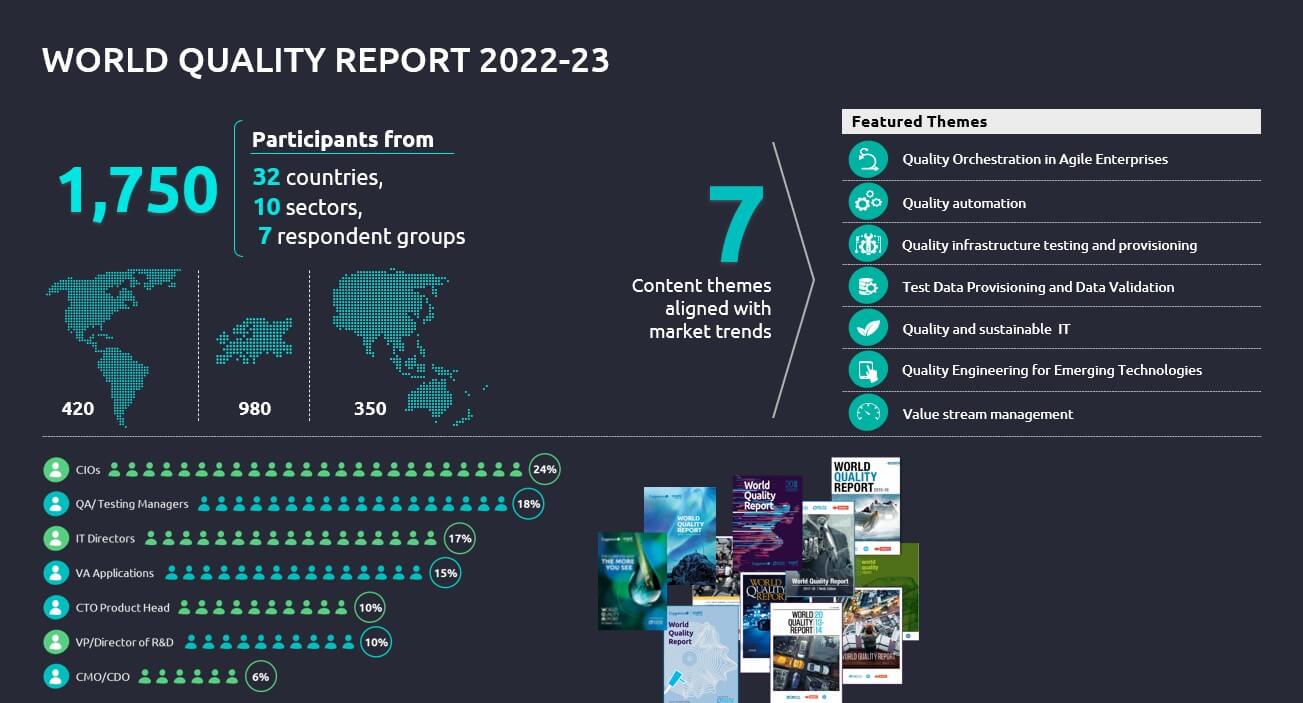In the last several years, organizations have been forced to evolve their IT solutions at breakneck speed. Regardless of industry, IT developments such as cloud migration, digital platform enhancement, and data-management tools have become necessities—not options. A McKinsey report from early in the pandemic stated that consumer and business digital adoption "vaulted five years forward . . . in a matter of around eight weeks."
Under this new pressure, digital solutions underwent quantum leaps in the speed of development, release, and user adoption. As the speed of these processes accelerated faster than the natural pace of IT evolution, a host of new risks arose in the IT development process—and the risk management burden fell squarely on quality assurance (QA) teams. Contracted iteration timelines meant that more sophisticated QA work had to happen earlier and at a greater depth than in pre-pandemic times.
Thus, existential questions for QA teams arose: How can QA teams adapt to shorter iteration timelines? How can they establish flexible, risk-controlled systems—in light not just of the pandemic, but also of all the secondary instability it caused (supply chain disruption, inflation, skilled-resource shortage, potential recession)?
These were the questions investigated by the World Quality Report (WQR) 2022-23, the 14th edition of Sogeti's (part of Capgemini) annual report.
A Brief History of Quality Assurance, from Guilds to Sustainable IT
The roots of QA reach back at least as far as the Middle Ages, when guilds were established so that master craftspeople could assess the quality of each other's work. In this initial iteration, QA was a slow, deliberate process—centering on the absolute quality of the craft in question.
The Industrial Revolution planted the seeds of the modern conception of QA, where efficiency and productivity are of the essence. Notions of employee training, protocol documentation, and work dispersal among employees and managers (a foreign concept in fiefdoms) came into being during this time.
In industrial settings, QA generally happens at the end of the manufacturing cycle. Car prototypes, for example, go through crash tests to assess safety levels. These quality tests, however, cannot be completed before the car has reached a mature manufacturing state. This brought about the rise of the develop-to-test framework.
The develop-to-test framework is carried over into the software-development process. Traditionally, QA in software development has centered on testing; once a software product has been developed, it is passed to QA teams for various types of testing—the last line of defense before getting released to customers.
The WQR suggests that the develop-to-test framework is due for disruption.
"The development and transformation of the QA function from pure testing to actual quality engineering practices is . . . required for companies to stay successful in their domain," the report reads.
Just as DevOps and FinOps made software developers responsible for operations and costs, today's breakneck pace of iteration has added QA to their burden as well. Witness the advent of quality engineers, people responsible for developing and implementing quality checks that occur throughout the software development lifecycle (SDLC)—not after it.
In the same way that the Industrial Revolution fused the seemingly opposed demands of quality and speed, the WQR argues that the Digital Revolution is fusing the once disparate functions of development and QA. This applies equally to software quality today and well into the future, as new paradigms like sustainable IT take hold.
The 6 Pillars of Transitioning from Quality Assurance to Quality Engineering
In compiling this year's WQR, Sogeti gathered responses from 1,750 respondents across 32 countries, 10 sectors, and seven respondent groups. Offering an in-depth look into the state of QA, this year's report offers six main pillars for organizations looking to make the transition to quality engineering (QE).
1. Orchestration
Orchestrating the right quality protocols at the right stages of the development process is central to success in QE. It appears that the right quality protocols are best orchestrated by quality engineers in agile development programs. According to the WQR, organizations implementing agile have lowered their time to market by 65%, increased software quality by 56%, and driven a 61% increase in customer experience.
2. Automation
Organizations should aim for end-to-end automation—reducing the manual testing burden as much as possible. The WQR states that automation should span planning, design, execution, and continuous quality monitoring. It also cautions that "ROI isn't everything." As organizations develop automated systems, they should concern themselves more with customer and process benefits than with immediate revenue impact.
3. Technology
Leading-edge technologies will facilitate the shift from QA to QE, according to the report. The report cautions, however, that there is no one absolute technological leader at present—and that each team will likely have to configure its own QE stack.
4. Provisioning
The report emphasizes the importance of automated data provisioning and cloud testing, reiterating that there is no single tool for either of these functions that stands above all the rest. In particular, the report characterizes cloud testing as "a box of chocolates," urging organizations to experiment with open source, off-the-shelf solutions, hybrid options, etc., and to pick a tool (or tools) based on efficacy.
5. Metrics
True QE, per the report, depends on metrics that function as "holistic quality indicators across the development lifecycle." Accordingly, organizations should develop universal quality metrics to be applied early on in—and tracked throughout—the SDLC.
6. Skills
People will drive the transition to QE. As such, people need to develop skills commensurate with the evolved QE function. The WQR advises that subject-matter expertise, platform knowledge, and business acumen should complement existing testing and engineering skill sets.
Looking into the Future of Quality Engineering
Looking beyond the pressures of the present moment, the WQR also outlines emerging trends that QE teams will want to consider, if not start addressing now—placing a particular focus on sustainable IT and value stream management (VSM).
Sustainable IT refers to the environmental sustainability of the software development process. As the relationship between IT and environmental impact is yet to be understood in full, the best thing for organizations to do now is to stay attuned to sustainable IT developments and understand that it is a goal they'll likely need to tackle in the near future.
VSM is the practice of applying value checks to each stage of the SDLC. It links each software-development activity to relevant business goals. The WQR indicates that 60% of organizations already apply the VSM approach to every development project.
The ever-increasing pace of social and industrial change means that organizations need to take a radically different approach to quality. Finding the right people, equipping them with the proper skills, implementing automated quality checks throughout the software-development process, and staying abreast of emerging technology trends (including blockchain, cybersecurity developments, sustainable IT, and VSM) will define success for modern organizations.
You can download the World Quality Report 2022-23 here.
Keep learning
Take a deep dive into the state of quality with TechBeacon's Guide. Plus: Download the free World Quality Report 2022-23.
Put performance engineering into practice with these top 10 performance engineering techniques that work.
Find to tools you need with TechBeacon's Buyer's Guide for Selecting Software Test Automation Tools.
Discover best practices for reducing software defects with TechBeacon's Guide.
- Take your testing career to the next level. TechBeacon's Careers Topic Center provides expert advice to prepare you for your next move.



